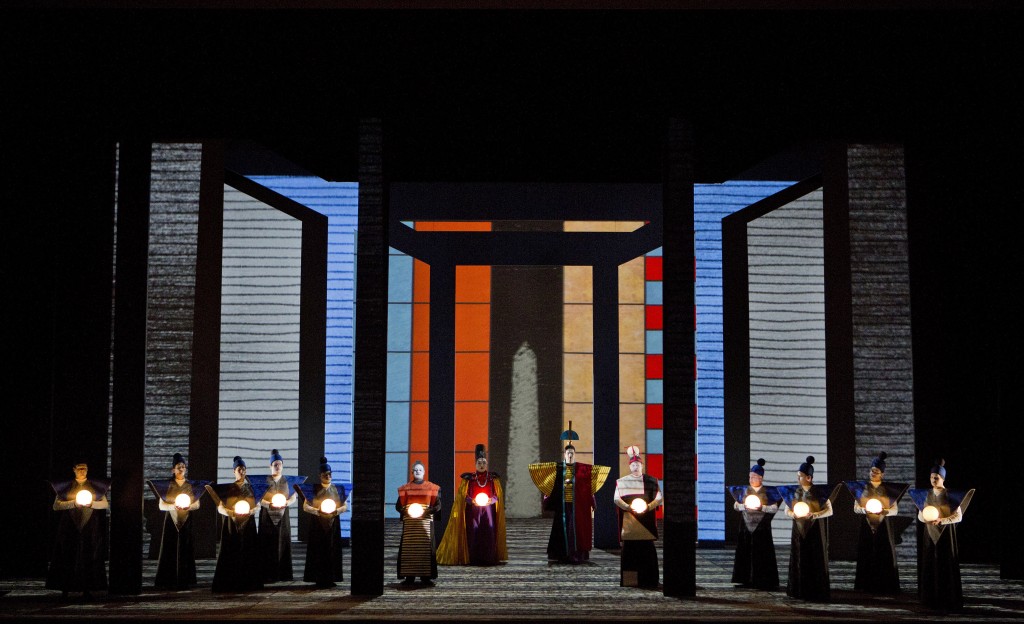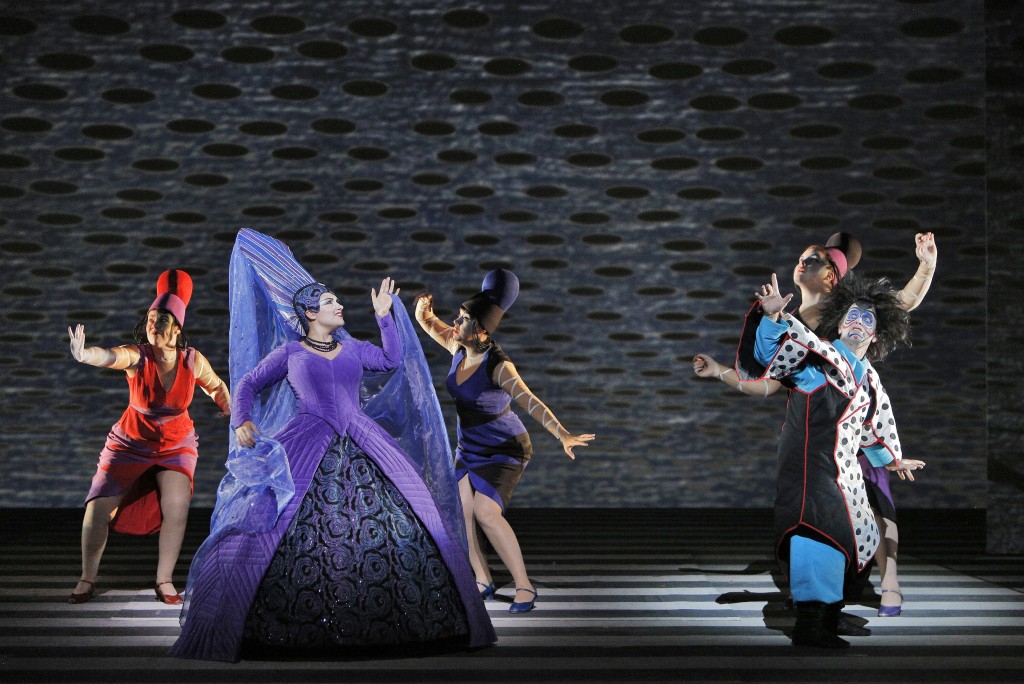By Paul Horsley
That the Lyric Opera’s new production of Mozart’s The Magic Flute is a banquet of visual delights is beyond question. Its wildly colorful scenic designs, digital animations and costumes by world-renowned sculptor Jun Kaneko are quite unlike anything we’ve seen on the Lyric stage: Playful and fun in often explosively eye-dilating ways, they nevertheless retain the integrity of Jun’s work as visual artist: Those familiar with his sculptures will find familiarity in the near-obsession with parallel lines, which in his sculpture and ceramic work often takes the form of long drips of molten glass. Moreover Jun has a remarkably musical ear, and this co-production with San Francisco Opera, which opened November 9th at the Kauffman Center, succeeds in translating Mozart’s music into visual language with incredible ingenuity. In the Overture, for example, a series of colored lines etch their way across the front scrim vertically and horizontally at first, and retreat: Then during the music’s “development section” the lines become curved and even confused to reflect the increased harmonic complexity of the musical/orchestral texture. If Jun’s designs are based more on the actual sound of the music than on the eclectic and at times darkly confounding content of Schikander’s libretto, the top-rank cast and musical team that the Lyric has assembled assures the production’s artistic success: Musically this is among the finer productions the company has mounted, even if the end result is as oddly troubling as Flute usually is. And because it’s sung and spoken in English, the story is coherent even without the Kauffman’s “Figaro” title system.

Photos by Cory Weaver
This opera is above all a conundrum, and for more than two centuries it has lent itself to an array of crazily unconventional treatments – partly because it’s not easy to figure out exactly what it’s about. On the surface: The old order represented by the Queen of the Night’s dark but not especially evil world and Sarastro’s vaguely misogynistic council of Masonic elders is seeking new blood, as represented by youthful hero Tamino and his equally important would-be bride, Pamina – the Queen’s daughter, whom Sarastro has nabbed from her mother “for her own protection” and locked up in a sort of harem.
Walking a fine line between the story’s fundamental silliness and the seriousness of establishing a benevolent world order is tricky, but not impossible. Stage director Harry Silverstein’s Act 1 is pure delight, its whimsical elements lending themselves easily to Jun’s visuals: The dragon that the Three Ladies slay for Tamino has two toothy heads, while the Ladies themselves are dressed in startling purple, tealish and red-orange gowns. Images of rings cascade downward on the upstage scrim while Tamino sings his famous “locket” aria, suggesting perhaps his yearning to marry the woman whose portrait he has just seen. Papageno is dressed in square-grid plaid and feathered vest and a crazed bird cap, while diminutive Monostatos sports a burst of frizzy hair. The Queen is stunning in red and gold with midnight blue cape, and rippling colored stripes splay out like a peacock tail on the scrim while she sings her Act 1 aria. The Three Boys (called “Spirits” here because they are sung by girls) enter high atop three green, red and gold ice-cream-cones – or are they inverted pyramids, perhaps, a subtle upsetting of the quasi-Masonic “Templar Knights” shape seen throughout the show? (Pyramids have long been a standard part of productions of Flute.) Even Pamina’s rather ungainly “petticoats” look like three pyramids stacked on top of one another. Tamino is dressed more demurely, in “royal” bluish purple, and his flute ushers in several fantastical figures representing a gaggle of barely identifiable creatures.

Act 2 is another matter. As it contains more serious content, Jun was correct in toning down the attention-grabbing visuals. It was also appropriate that Harry slowed down the stage action a bit as the libretto delved into deeper philosophical questions, though at times it felt there was too much stand-and-sing in the very parts where the notorious dramatic longeurs of Act 2 called for more movement. Pamina’s ensemble with the Spirits, for instance, seemed to yearn for some interaction between the quartet. More important, some of the more serious elements were treated to a level of whimsy that sometimes threw the dramatic pitch off-balance. We already had buffoonish denizens of the “harem” in Act 1, who are often cast as mildly menacing guys but in this case seemed hardly a threat. That point could perhaps be debated, but the “Armored Men” are, in my view, truly scary figures, and to have them skip onstage like robotic automatons robbed the scene of the gravity the music and text seem to convey.
Gary Thor Wedow led the KC Symphony with comfortable command, thoughtful musical ideas and brisk tempos (except for the Act 1 Quintet, which felt draggy). Ensemble was at times off, but not seriously so. But Pamina’s big Act 2 aria moved forward at a sensible pace, instead of noodling around arhythmically as it often does. In fact Lauren Snouffer as Pamina was the singer I was most taken with: With a bright, radiant, bell-like soprano she was just serious enough to convince you she was an emotional wreck. Shawn Mathey sang Tamino with strength and clarity, conveying ardor in both body language and his sweet, ringing tenor. Kathryn Lewek, a favorite Queen of the Night these days, nailed her otherworldly coloratura arpeggios to the wall in her “vengeance” aria, but more impressive to me was the pathos with which she quickly conveyed, in Act 1, the full suffering of a mother whose child has been kidnapped.

Daniel Belcher’s Papageno was fun throughout, sung capably and played with a savvy restraint that did not blunt the comedic moments (as when he motions to Tamino to “count him out” of the noble pledges). Andrew Gangestad drew my attention as the Speaker, his voice and demeanor always commanding (though I’m not sure why his face and those of other characters were painted kabuki-esque white). Stately Jeffrey Beruan as Sarastro sang with a glorious mid-range but struggled for the all-important growly low tones. Doug Jones played an athletic Monostatos, bouncing around with his lecherous desire for Pamina. The rest of the large cast sang with consistency across the board, and the chorus delivered a finely honed, full-bodied sound in all but a few passages. Special credit goes to the technical team, which offered up visuals that one rarely sees except in the most lavishly expensive Broadway productions: lighting designers Paul Pyant and Christ Maravich, wig and makeup designer Alison Hanks and a host of others.
The Magic Flute runs through November 17th. For tickets call 816-471-7344 or see kcopera.org.
To reach Paul, email phorsley@sbcglobal.net or hunt him down on Facebook (paul.horsley.501).
[slider_pro id=”2″]
[slider_pro id=”3″]
